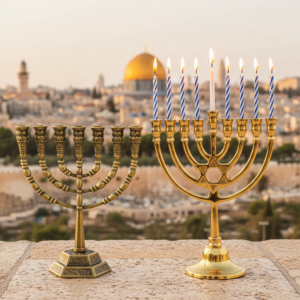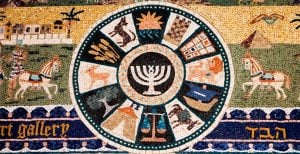The Biblical history of the Temple Mount’s (Moriah) begins with the story of the Binding of Isaac. G-d said to Abraham, “Take your son, your only son whom you love, Isaac, and go to the land of Moriah and offer him there as an offering on one of the Mountains which I will tell you” (Genesis 22:2). Abraham called the place “the Mountain where G-d is seen” (Genesis 22:14).
About a thousand years later at this very location, we are told that King David bought the land of the Temple Mount, the “threshing floor of Araunah the Jebusite” and built an altar to the Lord (2 Samuel 24:18, 21).
First Temple
The First Temple was built by King Solomon around 950 BC on “Mount Moriah.” In 586 BCE, the Temple was destroyed by the Babylonians and the Jews were killed or taken into exile.
Second Temple
In 536, Zerubbabel built the first phase of the Second Temple: “Now in the second year of their coming unto the house of God at Jerusalem, in the second month, began Zerubbabel … to set forward the work of the house of the Lord”) (Ezra 3: 8) Over 500 years the Temple was repaired and new walls were constructed, but the major renovations were performed by King Herod (37BC-4BC).
The Great Revolt
Following the Jewish revolt against the Romans, the Second Temple was destroyed in 70 CE by the Romans, just six years after its completion. Only a few remnants of this amazing structure remained, such as the Western Wall and Hulda Gates, while the platform became the basis for a pagan temple in a new Roman city called Aelia Capitolina.
Byzantine Empire
In the 4h century, the pagan Roman Empire became a Christian country and Jerusalem went form being a relatively insignificant provincial city to the focus of Christian pilgrimages and worship. A new church was built on the site of Hadrian’s Aphrodite temple and this church became the central religious site for the Christian city, replacing the Temple Mount.
Arab Period
The Arabs conquered Jerusalem in 638AD and in 691 built the Dome of the Rock shrine with its large golden dome and an octagon structure. Years later, another dome was built on the far south side, the Al-Aqsa mosque and additional Umayyad palaces and structures were constructed south of the Temple Mount.
Crusaders
In 1099, the Crusaders arrived on the scene and turned the Dome of the rock into a church, placing a cross on the dome and also turning Al-Aqsa mosque into a prayer house. The Crusaders were then expelled from Jerusalem by Saladin in 1187.
Ottoman Empire
During the 14th-20th centuries, with the rise of the Ottoman empire, the Temple Mount became a major Muslim prayer site again as new gates and walls were constructed around the Temple Mount and the city with several prayer domes and fountains added in the Temple Mount.
Modern Years
By 1967, the Jordanians had control of the West Bank and East Jerusalem,. During the Six-Day War, they attacked Israel together with Syria and Egypt. The Israelis defeated Jordanians took control of the West Bank and East Jerusalem, together with the Temple Mount. After 2000 years, a united Jerusalem had been reclaimed and reunited under Israeli sovereignty.
Unfortunately, when the Six-Day War was over, Israeli Prime Minister Levi Eshkol decided to return the authority of the Temple Mount to the Jordanians. To this day, while the Israelis technically have control over the Temple Mount, it remains in foreign hands.
Third Temple
The Bible indicates that the third Jewish Temple will be built on the Temple Mount (Daniel 9:27), ushering in the final redemption and Messianic era.












